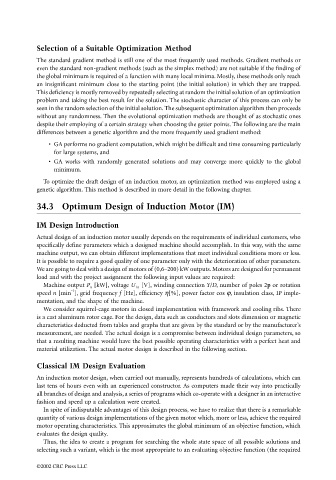Page 1010 - The Mechatronics Handbook
P. 1010
Selection of a Suitable Optimization Method
The standard gradient method is still one of the most frequently used methods. Gradient methods or
even the standard non-gradient methods (such as the simplex method) are not suitable if the finding of
the global minimum is required of a function with many local minima. Mostly, these methods only reach
an insignificant minimum close to the starting point (the initial solution) in which they are trapped.
This deficiency is mostly removed by repeatedly selecting at random the initial solution of an optimization
problem and taking the best result for the solution. The stochastic character of this process can only be
seen in the random selection of the initial solution. The subsequent optimization algorithm then proceeds
without any randomness. Then the evolutional optimization methods are thought of as stochastic ones
despite their employing of a certain strategy when choosing the getter points. The following are the main
differences between a genetic algorithm and the more frequently used gradient method:
• GA performs no gradient computation, which might be difficult and time consuming particularly
for large systems, and
• GA works with randomly generated solutions and may converge more quickly to the global
minimum.
To optimize the draft design of an induction motor, an optimization method was employed using a
genetic algorithm. This method is described in more detail in the following chapter.
34.3 Optimum Design of Induction Motor (IM)
IM Design Introduction
Actual design of an induction motor usually depends on the requirements of individual customers, who
specifically define parameters which a designed machine should accomplish. In this way, with the same
machine output, we can obtain different implementations that meet individual conditions more or less.
It is possible to require a good quality of one parameter only with the deterioration of other parameters.
We are going to deal with a design of motors of (0,6–200) kW outputs. Motors are designed for permanent
load and with the project assignment the following input values are required:
Machine output P n [kW], voltage U 1n [V], winding connection Y/D, number of poles 2p or rotation
-1
speed n [min ], grid frequency f [Hz], efficiency η[%], power factor cos ϕ, insulation class, IP imple-
mentation, and the shape of the machine.
We consider squirrel-cage motors in closed implementation with framework and cooling ribs. There
is a cast aluminum rotor cage. For the design, data such as conductors and slots dimension or magnetic
characteristics deducted from tables and graphs that are given by the standard or by the manufacturer’s
measurement, are needed. The actual design is a compromise between individual design parameters, so
that a resulting machine would have the best possible operating characteristics with a perfect heat and
material utilization. The actual motor design is described in the following section.
Classical IM Design Evaluation
An induction motor design, when carried out manually, represents hundreds of calculations, which can
last tens of hours even with an experienced constructor. As computers made their way into practically
all branches of design and analysis, a series of programs which co-operate with a designer in an interactive
fashion and speed up a calculation were created.
In spite of indisputable advantages of this design process, we have to realize that there is a remarkable
quantity of various design implementations of the given motor which, more or less, achieve the required
motor operating characteristics. This approximates the global minimum of an objective function, which
evaluates the design quality.
Thus, the idea to create a program for searching the whole state space of all possible solutions and
selecting such a variant, which is the most appropriate to an evaluating objective function (the required
©2002 CRC Press LLC

